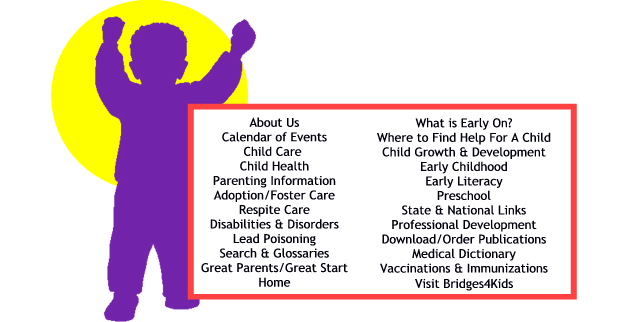|
by Teri Brown
for iParenting Magazine @
www.parentingstages.com

Babies and
toddlers get colds all the time. The worst symptoms of an average cold
last just a few days and then taper off. But what if your child begins
tugging at his ear, has trouble sleeping and seems more irritable than
usual? Chances are your child has developed an ear infection.
According to the American Academy of
Family Physicians, more than three out of four children will have at least
one ear infection by their third birthday. If left untreated, these
infections can lead to permanent hearing loss.
Ear Infections 101
Exactly what is an ear infection and how do you get them? Your ear
contains three main parts: the outer or visible ear, the middle ear and
the inner ear.
An ear infection, or acute otitis media
as it is also called, is when the middle ear, a grape-sized space behind
the ear drum, becomes filled with fluid that would normally drain out.
Because of unusually high amounts of liquid or inflammation due to a cold
or other reasons, however, it does not drain properly.
The Eustachian tube is a small tube
that leads to the back of the throat. This is the part that generally
becomes clogged. One reason children may be so susceptible to ear
infections is that their Eustachian tubes are much shorter than those of
an adult.
Symptoms
Trina Strahl, a homemaker from Beaverton, Ore., had no idea she was going
to become an expert on ear infections, but that is exactly what happened
when her son ended up with a series of chronic infections. "My son had
several dozen over a period of 14 months," says Strahl. "He was on
medication more than he was off."
Strahl became used to the symptoms that
signaled another infection – fever, intense crying, night waking,
listlessness and digging at his ears. "Eventually, this was routine
behavior," says Strahl. "Toward the end, he had become resistant to so
many medications, they no longer cleared the fluid from his ears, and he
was diagnosed with a chronic infection."
According to Dr. James Thomsen, a
specialist in otolaryngology for Children's Healthcare of Atlanta and
Pediatric Ear, Nose & Throat of Atlanta, the most common symptoms of ear
infection in children are:
-
Ear pain or pulling at the ears;
-
Fever;
-
A temporary decrease in hearing;
-
Fussiness or not being able to sleep;
-
Vomiting or diarrhea;
-
Lack of appetite;
-
Pus draining from the ear.
Other Causes
Though ear infections are the most common cause of ear pain, your child's
ears may hurt for reasons other than a typical middle ear infection, such
as an infection of the ear canal skin (sometimes known as swimmer's ear),
a sore throat or teething or sore gums.
The causes of ear infections vary, but
there are high-risk groups that are more likely to develop ear infections
than others. "Upper respiratory infections are one common cause of ear
infections," says Dr. Thomsen. "However, exposure to smoke, attending a
large group daycare and lying down while drinking a bottle will also
increase your child's risks."
Other risk factors include:
-
Previous ear infections, particularly
if the infections occurred before the child's first birthday;
-
A family history of ear infections;
-
Being premature or a low birth
weight;
-
Being a boy (boys tend to have more
middle ear infections than girls);
-
Frequent colds or other infections;
-
Taking a bottle to bed.
Diagnosis and Treatment
Because a small child's language hasn't developed to the point of being
able to tell you the where he hurts, diagnosis is generally done by a
doctor who can look in your child's ear with an instrument called an
otoscope. The doctor will inspect the outer ear and the eardrum, searching
for inflammation, which indicates an infection. If it is found, you and
your pediatrician will then decide on a method of treatment.
"Your child's doctor will talk with you
about specific care for your child," says Dr. Thomsen. These might include
giving acetaminophen (Tylenol, Tempra, Panadol) for pain and fever.
Thomsen suggests that you ask your child's doctor how much of this type of
medicine to give. Other methods of treatment your doctor may suggest are:
encouraging your child to drink plenty of fluids, avoid exposing your
child to cigarette smoke, not allowing your child to take a bottle to bed
and being consistent in giving your child the antibiotic your doctor
prescribes.
Many ear infections resolve
spontaneously when the Eustachian tube begins to function normally again.
Controlling the more painful symptoms of ear infections with acetaminophen
or topical anesthetics is generally helpful in making your child more
comfortable.
Antibiotics are typically used for five
to 10 days if the healthcare provider thinks the child has acute otitis
media. Because many doctors are mindful of the amount of antibiotics they
give, some experts have advocated "watchful waiting" for children over 2
years of age, a strategy in which antibiotics are not given unless there
is no improvement in 48 to 72 hours.
If your child has recurring ear
infections you may want to seek out a specialist. An otolaryngologist,
also known as an ENT specialist (Ear Nose Throat doctor), will determine
if infections are causing permanent damage to your child's hearing. If
this is the case, your doctor may suggest tubes.
For Strahl, the trauma of the surgery
was minimized by how efficiently it was done and by the long-term effects.
"He screamed when we gave him to the surgeon, and we felt horrible," says
Strahl. She went to call her mother, and before she knew it they were
bringing him back to her. "Frankly, I fought tubes from the beginning, but
wish I had taken that approach more quickly after the immediate relief it
brought," she says.
To many parents, ear tubes are
something to be avoided at all cost, but others find, as Strahl did, that
the relief they bring is far better than constantly struggling with the
reoccurrence of infections.
Want to see more?
About the Author: Teri Brown is an
iParenting
contributing writer based in Portland, Ore.
|
